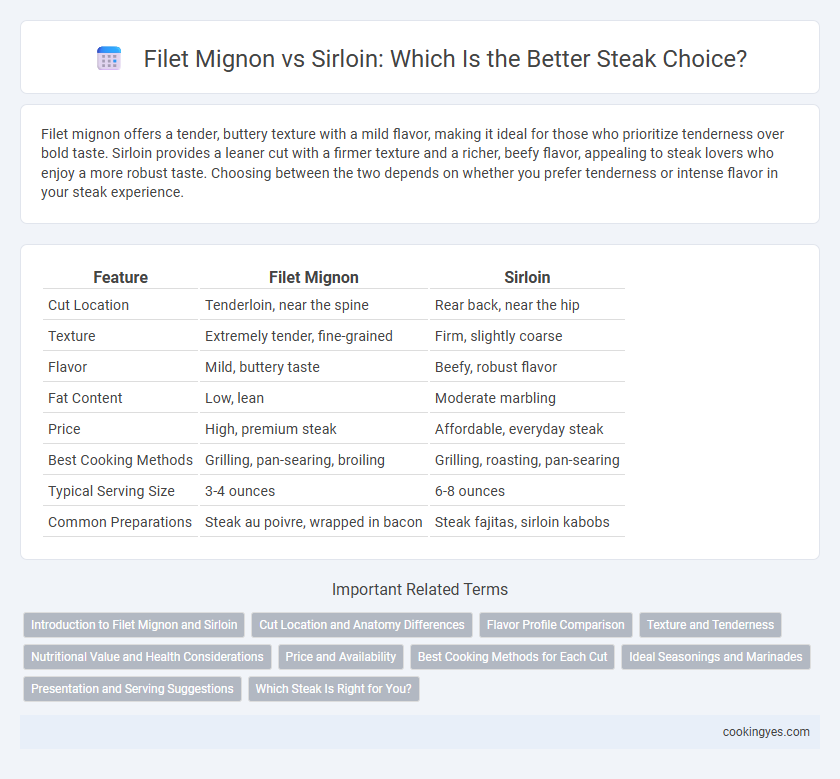Filet mignon offers a tender, buttery texture with a mild flavor, making it ideal for those who prioritize tenderness over bold taste. Sirloin provides a leaner cut with a firmer texture and a richer, beefy flavor, appealing to steak lovers who enjoy a more robust taste. Choosing between the two depends on whether you prefer tenderness or intense flavor in your steak experience.
Table of Comparison
| Feature | Filet Mignon | Sirloin |
|---|---|---|
| Cut Location | Tenderloin, near the spine | Rear back, near the hip |
| Texture | Extremely tender, fine-grained | Firm, slightly coarse |
| Flavor | Mild, buttery taste | Beefy, robust flavor |
| Fat Content | Low, lean | Moderate marbling |
| Price | High, premium steak | Affordable, everyday steak |
| Best Cooking Methods | Grilling, pan-searing, broiling | Grilling, roasting, pan-searing |
| Typical Serving Size | 3-4 ounces | 6-8 ounces |
| Common Preparations | Steak au poivre, wrapped in bacon | Steak fajitas, sirloin kabobs |
Introduction to Filet Mignon and Sirloin
Filet Mignon is a tender, lean cut from the smaller end of the beef tenderloin, prized for its buttery texture and mild flavor. Sirloin steak comes from the rear back portion of the cow, offering a balance of tenderness and robust beefy taste at a more affordable price point. Understanding the distinct qualities of Filet Mignon and Sirloin helps steak enthusiasts choose the perfect cut for their desired flavor and texture experience.
Cut Location and Anatomy Differences
Filet Mignon is cut from the tenderloin, a muscle located along the spine that does minimal work, resulting in a tender texture with fine grain and minimal fat. Sirloin comes from the area near the rear back of the cow, specifically situated above the hip bone, containing a blend of muscle groups that provide a firmer texture and more pronounced beef flavor. The anatomical difference between these cuts significantly affects their tenderness and flavor profile, with filet mignon prized for softness and sirloin valued for robust taste.
Flavor Profile Comparison
Filet Mignon offers a buttery, tender texture with a mild, delicate flavor, prized for its melt-in-the-mouth quality due to fine marbling and minimal connective tissue. Sirloin exhibits a robust, beefy taste with a firmer texture and slightly chewier bite, attributed to its leaner cut and muscular placement, enhancing savory and umami notes. Both cuts provide distinct sensory experiences, with Filet Mignon excelling in tenderness and subtlety, while Sirloin delivers boldness and meatiness.
Texture and Tenderness
Filet Mignon is prized for its exceptional tenderness due to its fine-grained, lean muscle fibers, making it the most tender cut of beef. Sirloin offers a firmer texture with more pronounced muscle grain, resulting in a balance between tenderness and a beefier chew. The marbling in sirloin provides additional flavor, while filet mignon's buttery texture comes from its minimal connective tissue.
Nutritional Value and Health Considerations
Filet mignon, known for its tenderness, is lower in fat and calories compared to sirloin, making it a leaner choice for those monitoring fat intake. Sirloin offers higher protein content and contains more iron and zinc, essential for muscle function and immune health. Choosing between filet mignon and sirloin depends on balancing preference for lower fat versus higher micronutrient density in a steak.
Price and Availability
Filet Mignon commands a higher price due to its tenderness and fine marbling, making it a premium choice for steak enthusiasts. Sirloin offers greater affordability and more widespread availability in grocery stores and restaurants, appealing to budget-conscious consumers. Both cuts provide distinct flavor profiles, but price and access often dictate selection.
Best Cooking Methods for Each Cut
Filet Mignon, known for its tender texture and mild flavor, is best cooked using high-heat methods like grilling, pan-searing, or broiling to preserve its delicate juiciness and achieve a perfect medium-rare finish. Sirloin, a leaner and more flavorful cut, benefits from methods such as grilling, pan-frying, or roasting, which enhance its robust taste while maintaining tenderness when cooked to medium or medium-rare. Both cuts require proper resting time after cooking to ensure even juice distribution and optimal flavor.
Ideal Seasonings and Marinades
Filet Mignon's tender, mild flavor pairs best with simple seasonings like salt, pepper, garlic, and rosemary, enhancing its natural buttery texture without overpowering it. Sirloin benefits from bold marinades containing soy sauce, Worcestershire, garlic, and herbs that tenderize the lean cut and infuse robust, savory flavors. Both cuts improve with a dry rub or marinade containing acid elements like lemon juice or vinegar to balance richness and enhance juiciness.
Presentation and Serving Suggestions
Filet mignon offers an elegant presentation with its thick, round shape and tender texture, making it ideal for upscale plating and garnishing with fine herbs or a dollop of compound butter. Sirloin, with its broader, flatter cut, lends itself well to rustic presentations alongside robust sides like grilled vegetables or chimichurri sauce. Serving filet mignon often involves minimalist accompaniments to highlight its delicate flavor, while sirloin pairs excellently with bold seasonings and hearty starches, catering to a more casual, hearty meal experience.
Which Steak Is Right for You?
Filet mignon offers a tender, buttery texture with minimal fat, ideal for those seeking a lean, melt-in-your-mouth steak experience. Sirloin provides a more robust, beefy flavor with moderate marbling, catering to individuals who prefer a balance between tenderness and taste. Choosing between filet mignon and sirloin depends on whether you prioritize tenderness or flavor intensity in your steak.
Filet Mignon vs Sirloin for Steak Infographic

 cookingyes.com
cookingyes.com